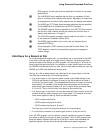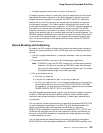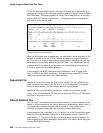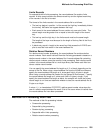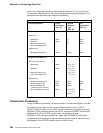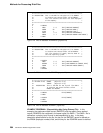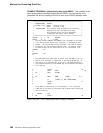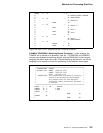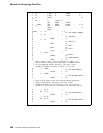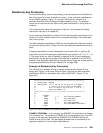Methods for Processing Disk Files
If, in the same job or activation group, two logical files use the same physical file,
and one file is processed consecutively and one is processed for random update, a
record can be updated that has already been placed in the buffer that is presented
to the program. In this case, when the record is processed from the consecutive
file, the record does not reflect the updated data. To prevent this problem, use the
CL command OVRDBF and specify the option SEQONLY(*NO), which indicates
that you do not want multiple records transferred for a consecutively processed file.
For more information on sequential only processing, see the
DB2 UDB for AS/400
Database Programming
.
Sequential-by-Key Processing
For the sequential-by-key method of processing, records are read from the file in
key sequence.
The sequential-by-key method of processing is valid for keyed files used as
primary, secondary, or full procedural files.
For output files and for input files that do not use random functions (such as
SETLL, SETGT, CHAIN, or ADD) and that have only one record format, the ILE
RPG compiler defaults to or operates as though SEQONLY(*YES) had been speci-
fied on the CL command OVRDBF. (The ILE RPG compiler does not operate as
though SEQONLY(*YES) had been specified for update files.) SEQONLY(*YES)
allows multiple records to be placed in internal data management buffers; the
records are then passed to the ILE RPG compiler one at a time on input.
If, in the same job, two files use the same physical file, and one file is processed
sequentially and one is processed for random update, a record could be updated
that has already been placed in the buffer that is presented to the program. In this
case, when the record is processed from the sequential file, the record does not
reflect the updated data. To prevent this problem, use the CL command OVRDBF
and specify the option SEQONLY(*NO), which indicates that you do not want mul-
tiple records transferred for a sequentially processed file.
For more information on sequential only processing, see the
DB2 UDB for AS/400
Database Programming
manual.
Examples of Sequential-by-Key Processing
The following three examples show you different ways of using the
sequential-by-key method of processing data.
DATA DESCRIPTION SPECIFICATIONS (DDS):
Figure 144 on page 294 and
Figure 145 on page 294 shows the data description specifications (DDS) for the
physical files used by the examples. Figure 146 on page 294 shows the DDS for
the logical file used by the first three examples.
Chapter 16. Accessing Database Files 293



